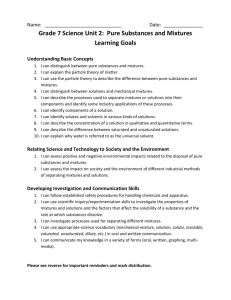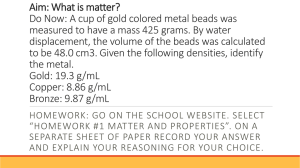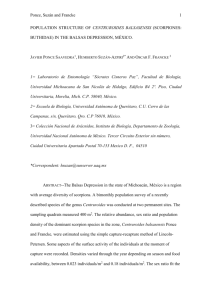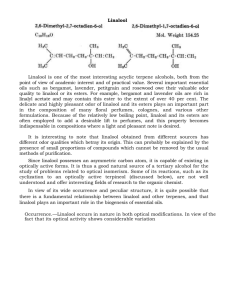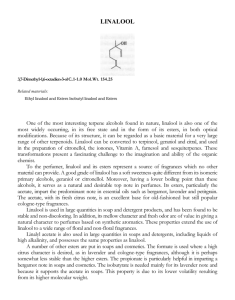Electronic Supplementary Material The Chemical Basis of Host
advertisement
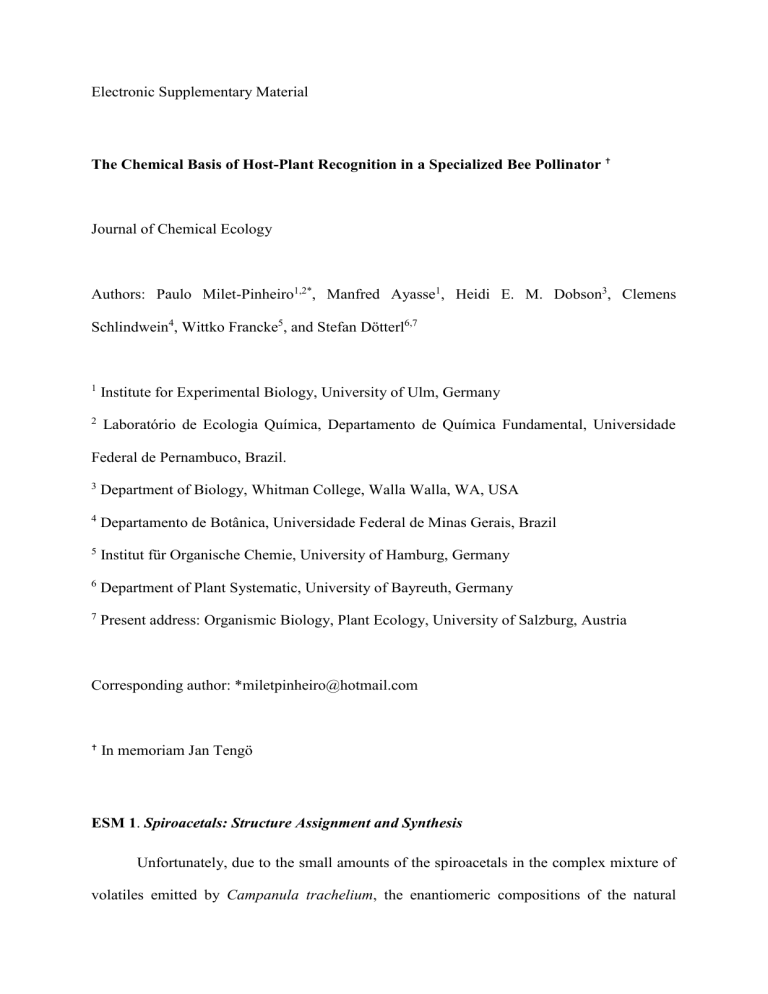
Electronic Supplementary Material The Chemical Basis of Host-Plant Recognition in a Specialized Bee Pollinator Journal of Chemical Ecology Authors: Paulo Milet-Pinheiro1,2*, Manfred Ayasse1, Heidi E. M. Dobson3, Clemens Schlindwein4, Wittko Francke5, and Stefan Dötterl6,7 1 Institute for Experimental Biology, University of Ulm, Germany 2 Laboratório de Ecologia Química, Departamento de Química Fundamental, Universidade Federal de Pernambuco, Brazil. 3 Department of Biology, Whitman College, Walla Walla, WA, USA 4 Departamento de Botânica, Universidade Federal de Minas Gerais, Brazil 5 Institut für Organische Chemie, University of Hamburg, Germany 6 Department of Plant Systematic, University of Bayreuth, Germany 7 Present address: Organismic Biology, Plant Ecology, University of Salzburg, Austria Corresponding author: *miletpinheiro@hotmail.com In memoriam Jan Tengö ESM 1. Spiroacetals: Structure Assignment and Synthesis Unfortunately, due to the small amounts of the spiroacetals in the complex mixture of volatiles emitted by Campanula trachelium, the enantiomeric compositions of the natural products could not be determined. However, we tentatively assigned (5S,7S)- and (5R,7S)configuration to the conophthorin isomers and (2R,6S)-configuration to the 2-methyl-1,7dioxaspiro[5.5]undecane isomer, because these configurations had been found in other sources (Francke and Kitching 2001; Zhang et al. 2002; Goubault et al. 2008). In analogy to the decision made for conophthorin, the two isomers of 7-ethyl-1,6-dioxaspiro[4.5]decane in Ca. trachelium were tentatively assigned to keep (5S,7S)- and (5R,7S)-configuration. In this context, it should be noted, that insects might not react to spiroacetals showing the nonnatural configuration (Tengö et al. 1990; Zhang et al. 2002). The synthesis of spiroacetals followed known methods. Racemic 1,6-dioxaspiro[4.5]decane was prepared from tetrahydropyran-2-one (Alfa Aesar) and propargylalcohol (Aldrich) according to Doubský et al. (2004). Similarly, (5S,7S)-7-ethyl-1,6-dioxasprio[4.5]decane was obtained by coupling tetrahydrofuran-2-one (Aldrich) with (3S)-5-hexyne-3-ol, which had been prepared from acetylene and (S)-ethyloxiran (Aldrich). The synthesis of (5S,7S)-7methyl-1,6-dioxapsiro[4.5]decane (conophthorin) (Zhang et al. 2002) and (2R,6S)-2-methyl1,7-dioxaspiro[5.5]undecane (Goubault et al. 2008) have been described earlier. The reaction sequence proceeded straight forward and produced good yields. Analytical data were as expected. Due to the double anomeric effect at the spiro-center, 1,6-dioxaspiro[4.5]decane keeps the E-configuration. For the same reason, the stereochemistry at the spirocenter of 7ethyl-1,6-dioxaspiro[4.5]decane was controlled by the stereogenic center introduced at C7, which in turn, was fixed through the use of (3S)-hexyne-3-ol as a starting material (Francke et al. 1980; Deslongchamps et al. 1981). As a result, (5S,7S)-7-ethyl-1,6-dioxaspiro[4.5]decane was formed in high purity, accompanied by very small amounts of its (5R,7S)-diastereomer. ESM 2. Preparation of Synthetic Mixtures for Behavioral Experiments In all mixtures, individual substances were offered in absolute amounts comparable to those found in the inflorescence headspace samples of Ca. trachelium (see the Table 1 below). As each substance has a different vapor pressure and a different response factor in GC/MS, we established amounts to be added to the mixture by direct calibration. To do so, we prepared a synthetic mixture (10 µl of each EAD-active compound at 10-4 (v/v) in acetone), dropped 10 µl onto a filter paper (2 cm2), and after evaporation of acetone collected the scent released from the paper by dynamic headspace using quartz microvial adsorbent tubes as described above. Volatiles were collected for 30 min, the duration of each behavioral experiment. The sample was analyzed by GC/MS, and the total amount of each compound was calculated (according to the method described above). Based on the amount of the substances in this sample, new mixtures were calibrated, so that the amount of each compound was adjusted to the amount in the floral headspace samples. The total amount of each compound found in 10 µl of such mixtures was equivalent to that emitted by 80 flowers of Ca. trachelium during 30 min. Given that Ca. trachelium grows in open areas, where several individual plants or stems typically grow together and considering that a single plant can bear more than 30 flowers, the amount of the synthetic mixtures was equivalent to that which Ch. rapunculi bees come across under natural conditions in the field. With the exception of the spiroacetals, which were newly synthesized, terpinolene (97%), and α-copaene (97%), which were available in the stock of the Department of Plant Systematics (University of Bayreuth) and of the Institute for Experimental Biology (University of Ulm), respectively, the compounds used for preparing the synthetic mixtures were purchased from commercial suppliers: geranylacetone (in mixture with nerylacetone, >97%), linalool (97%), methyl salicylate (>98%), ß-ocimene (mixture of isomers, 90%), phenylacetaldehyde (99%), 2-phenylethyl acetate (99%), and 2-phenylethanol (99%) from Sigma-Aldrich, furanoid linalool oxide (mixture of isomers, ≥97%) and 2-nonanone (≥97%) from Fulka, and guaiacol (>98%) from Merck. 1 2 ESM 2. Table 1. Synthetic mixtures of floral volatiles used in behavioral experiments. Absolute amounts of volatiles found in headspace 3 samples of Campanula trachelium inflorescences (N = 6) used to make synthetic mixtures. The quantity of volatiles in each inflorescence 4 headspace sample (about 80 flowers) was calculated for a sampling time of 30 min, which was the duration of each behavioral experiment. Ca. trachelium Compounds (ng/30min*flower) Synthetic mixtures Median (min; All max) compounds 1.32 (0.71; 3.74) 0.69 Phenylacetaldehyde 2.63 (0.01; 12.68) 4.43 7.84 Guaiacol 0.03 (0.18; 0.01) 0.17 0.21 Methyl salicylate* 0.66 (0.04; 3.29) 0.92 2.28 2-Phenylethyl acetate 0.07 (0.06; 0.22) 0.19 0.21 2-Phenylethanol 4.54 (1.27; 12.68) 4.43 6.11 Aliphatics Aromatics Spiroacetals Monoterpenes Aliphatics 2-Nonanone 1.05 Aromatics Terpenoids (E)-β-Ocimene trans-Linalool oxide (furanoid) 46.84 (12.31; 90.24) 0.03 (tr; 0.32) 48.6 60.22 0.19 0.24 4 Ca. trachelium Compounds (ng/30min*flower) Synthetic mixtures Median (min; All max) compounds Terpinolene* 0.06 (0.02; 0.33) 0.2 0.25 Linalool* 2.15 (1.23; 4.86) 2.12 4.22 α-Copaene 0.38 (0.09; 0.62) 0.06 0.63 Geranylacetone 0.24 (0.16; 0.32) 0.88 0.26 0.01 (tr; 0.05) 0.02 0.01 0.3 (0.13; 1.76) 0.32 0.46 0.09 (0.07; 0.57) 0.59 0.58 0.77 (0.42; 3.16) 1.12 1.25 Aliphatics Aromatics Spiroacetals Monoterpenes Spiroacetals 1,6-Dioxaspiro[4.5]decane (5S,7S)-Conophthorin (2R,6S)-2-Methyl-1,7dioxaspiro[5.5] undecane (5S,7S)-7-Ethyl-1,6dioxaspiro[4.5]decane 5 5 6 References 7 Deslongchamps P, Rowan DD, Pothier, N (1981) The acid-catalyzed oxido-reduction of 8 spiroketals. Evidence for stereoelectronic control in hydride transfer to cyclic 9 oxenium ions. Can. J. Chem. 59:2787. 10 11 Doubský J, Strunz LD, Zednik J, Koutek B (2004) Alkynyltrifluoroborates as versatile tools in organic synthesis: A new route to spiroacetals. Org. Lett. 6:4909-4911. 12 Francke W, Kitching W (2001) Spiroacetals in Insects. Curr. Org. Chem. 5:233-251. 13 Francke W, Reith W, Sinnwell V (1980) Bestimmung der relativen Konfiguration bei 14 15 Spiroketalen durch 1H- und 13C-NMR-Spektroskopie. Chem. Ber. 113:2686-2693. Goubault M, Batchelor TP, Romani R, Linforth RST, Fritzsche M, Francke W, HARDY 16 ICW (2008) Volatile chemical released by bethylid wasps: identity, phylogeny, 17 anatomy and behaviour. Biol. J. Linn. Soc. 94:837-852. 18 Tengö J, Ågren L, Baur B, Isaksson R, Liljefors T, Mori K, König W, Francke W (1990) 19 Andrena wilkella male bees discriminate between enantiomers of cephalic secretion 20 components. J. Chem. Ecol. 16:429-441. 21 22 Zhang Q, Tolasch T, Schlyter F, Francke W (2002) Enantiospecific antennal response of bark beetles to spiroacetal (E)-conophthorin. J. Chem. Ecol. 29:1839-1852. 6



